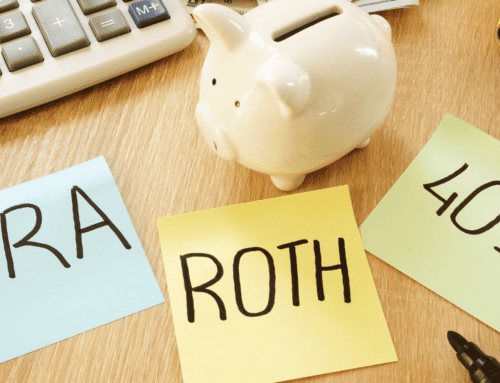
Understanding and effectively utilizing your tax-advantaged retirement savings options can have a big impact on your current and future finances.
Traditional Accounts
Many employers offer tax-advantaged traditional 401(k) accounts or similar employer-sponsored plans for retirement savings. With these accounts, you contribute a percentage of your pre-tax income into an investment account and can only withdraw funds once you retire. Since the contributions are taken from your salary, it can lower your income for the year, meaning you’ll owe less in taxes now. The tradeoff is that the funds in these accounts grow tax-deferred, so you only pay taxes on what you contributed + your earnings when you withdraw them.
Benefits of Traditional Accounts:
- Pre-Tax Contributions: Contributions to a traditional 401(k) account are made with pre-tax dollars, reducing your taxable income for the year, which can lead to immediate tax savings.
- Tax-Deferred Growth: Investments grow tax-deferred, meaning you don’t pay taxes on the earnings until you withdraw them.
- Employer Matching Contributions: Many employers offer matching contributions to your 401(k), which can significantly increase your retirement savings without any additional tax burden until withdrawal.
Things to Keep in Mind About Traditional Accounts:
- Taxation Upon Withdrawal: If you’re in a higher tax bracket post-retirement, you’ll pay more in taxes than you would’ve if you’d paid it before.
- Required Minimum Distributions (RMDs): Starting at age 72, you must take minimum distributions, which can increase your taxable income in retirement, regardless of whether you need the funds and would prefer to have that money invested.
- Penalty for Early Withdrawal: Withdrawing funds before the age of 59½ typically incurs a 10% penalty in addition to the income tax owed, reducing the amount available for use.
Roth Accounts
Many 401(k) plans offer an alternative to the traditional accounts called Roth accounts. Roth contributions are made with after-tax dollars— they don’t reduce your taxable income in the year you contribute. The benefit comes later because you can withdraw your contributions and earnings tax-free in retirement. If you anticipate a higher tax bracket later, Roth accounts offer a golden opportunity to lock in today’s lower rate, potentially saving you significant retirement savings.
Benefits of Roth Accounts:
- Tax-Free Withdrawals in Retirement: Withdrawals from a Roth account in retirement are tax-free.
- No Required Minimum Distributions (RMDs) for Roth IRAs: Unlike traditional plans, Roth accounts do not require minimum distributions starting at age 72, allowing your investments to grow tax-free for as long as you choose.
- Potential Estate Planning Benefits: Since contributions are already taxed, they don’t count towards your taxable estate, potentially reducing the tax burden on your heirs. Additionally, beneficiaries can withdraw tax-free Roth 401(k) contributions, maximizing the benefit.
Things to keep in mind about Roth Accounts::
- No Immediate Tax Deduction: Contributions to Roth accounts are made with after-tax dollars, and there is no immediate tax deduction for your contributions, unlike traditional retirement accounts.
- Income Limits for Roth IRA Contributions: Roth IRAs have income limits; high earners may be partially or entirely phased out from making direct contributions, although backdoor Roth IRA strategies exist for those who exceed these limits.
- Limited Employer Match Benefits for Roth 401(k)s: While contributions to a Roth 401(k) are made with after-tax dollars, any employer match is contributed to a traditional 401(k) account and is taxable upon withdrawal.
Traditional vs. Roth
Think of retirement taxes like toll booths on a financial highway. A Roth account lets you pay a flat fee upfront (taxes on contributions) and then cruise through retirement without further tolls (tax-free growth and withdrawals). In contrast, a traditional account offers a free ride now (tax break on contributions) but charges you at the end of the trip (taxes on earnings). If you expect the toll prices to rise in retirement and can afford the toll now, Roth’s upfront payment could be the wiser choice.
Choosing the right retirement savings option can reduce your current or future tax burden, allow your savings to grow more efficiently, and secure a brighter financial future for your retirement years.
While we hope you find this content useful, it is only intended to serve as a starting point. Your next step is to speak with a qualified, licensed professional who can provide advice tailored to your individual circumstances. Nothing in this article, nor in any associated resources, should be construed as financial or legal advice. Furthermore, while we have made good faith efforts to ensure that the information presented was correct as of the date the content was prepared, we are unable to guarantee that it remains accurate today.
Neither Banzai nor its sponsoring partners make any warranties or representations as to the accuracy, applicability, completeness, or suitability for any particular purpose of the information contained herein. Banzai and its sponsoring partners expressly disclaim any liability arising from the use or misuse of these materials and, by visiting this site, you agree to release Banzai and its sponsoring partners from any such liability. Do not rely upon the information provided in this content when making decisions regarding financial or legal matters without first consulting with a qualified, licensed professional.



